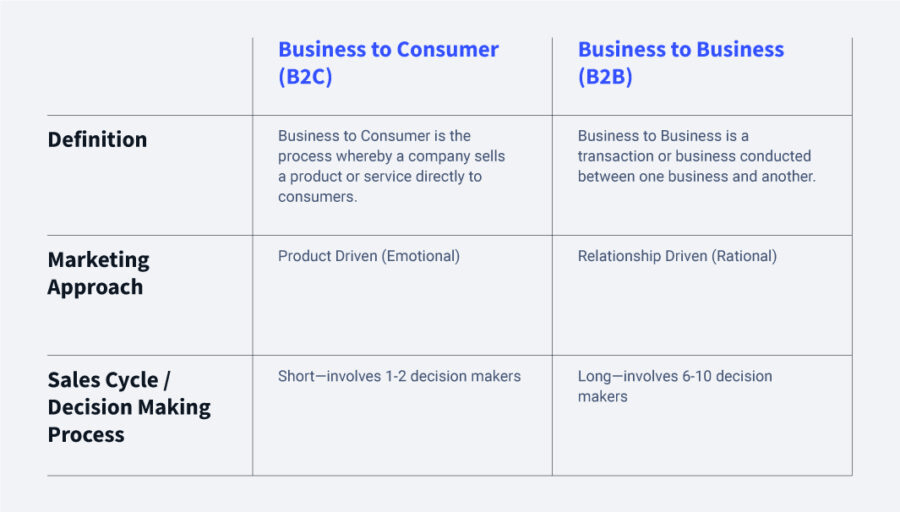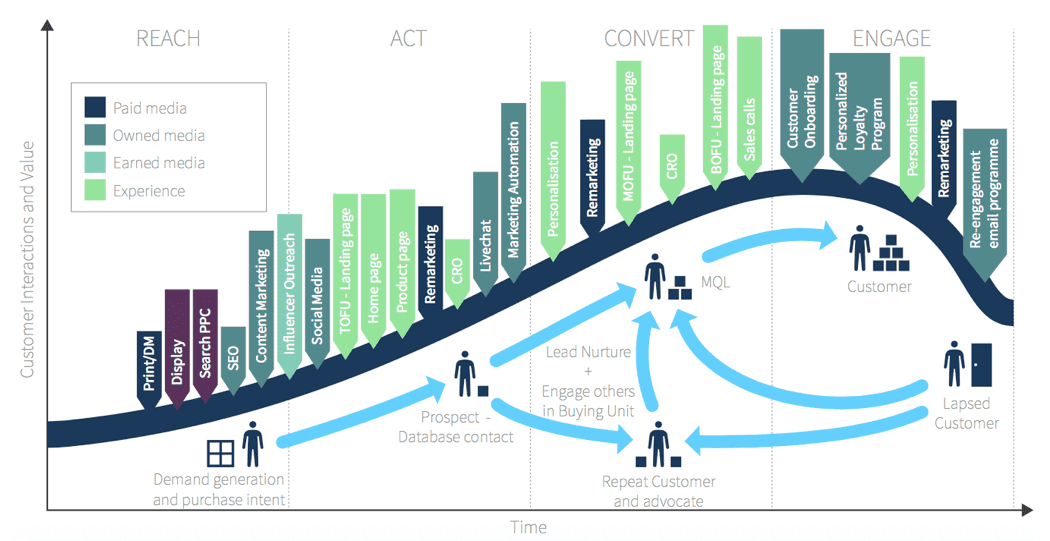Successful B2B (b2b stands for business to business) and B2C (b2b stands for business to consumer) sales rely on in-depth knowledge of targeted customer bases. While both of these business models involve sales, there are key differences between the worlds of B2B and B2C. Customers for each of these business models base their decisions on different factors. Understanding the decision-making process and buyer intent in B2B sales versus B2C will help you optimize the sales process.
Continue reading or ‘jump ahead’ to the following topics:
- B2B Vs. B2C Mindsets
- The Markets of B2B Vs. B2C Models
- The B2B Decision Making Process
- Influencing the B2B Purchasing Decision
- B2B & B2C Customer Lifecycle and Buyer Journey
B2B Vs B2C Mindsets

B2B companies sell their products and services directly to other businesses. B2C companies sell directly to consumers. There is no right or wrong business model, but B2B and B2C have different mindsets when it comes to the sales process and buyer intent.
In a B2C environment, the product is being directly marketed and sold to the customer. There is no middle man in this process.
Customers are directly interacting with the business during their purchase. With this model, customers tend to make purchases based on emotion.
Since the customer is directly involved, the emotional investment carries more weight in a B2C market. Advertising in the B2C world usually appeals to the customer by invoking feelings about the product. For example, a primary motivator to make a purchase may be because the product and advertisement make the customer feel happy.
B2C purchases typically see a shorter buying cycle. Customers tend to be less informed about the differences between competitive products.
It is easy for the business to capitalize on the quick decision process of these consumers
With B2C, there are fewer parties involved in the purchase. This allows B2C companies to relate directly to their targeted customers without waiting for their product to be approved by multiple decision-makers.
A B2B business focuses more on the logic behind buyer intent. B2B consumers tend to spend more time on research, and the sales cycle is longer. Typically, these purchases are larger in quantity, and the product has the ability to affect an entire company.
Because B2B consumers spend more time on research between competing products, B2B marketing tactics tend to lean on product information to sell products and avoid emotional appeals. B2B buyers invest time in the purchasing process, which allows them to thoroughly research and understand the product and compare it to alternative solutions offered by competitors.
The Markets of B2B Vs B2C Models
B2B models rely heavily on customer retention and strong client relationships. Since the sales cycle is longer and requires more resources in their sales and marketing, it is crucial for these companies to have successful customer outreach. B2B sales teams must be prepared to speak with multiple stakeholders throughout the sales cycle, and the product must have broad appeal to the client.
A B2C model has a larger consumer base, but only targets customers on an individual basis. Most likely, any purchase made from a B2C company will be on a smaller scale with the majority of the decision-making done by a single buyer. That’s one of the key difference between b2b and b2c businesses.
Because of this B2B models tend to focus on a large-scale market. Typically, the products and services being sold aim to solve a problem that an entire team within a company is facing.
Understanding the price points of these purchases provides insight into the value of the product. The average B2C sale is $147. In contrast, the average B2B sale is much higher at $491. The vast difference between the average sale totals in the two business models illustrates the divergence in sales cycle length.
When B2B consumers are considering making a purchase, the higher price tag helps encourage a more informed buying process and buyer intent. The value of this purchase will most likely reach larger numbers of people since these services and products target entire organizations, teams, or departments.
The B2B Decision Making Process
Understanding the B2B buying process and buyer intent of B2B customers will help your company streamline its sales efforts.
It is important to keep customers engaged throughout the sales cycle. B2B sales rely on informational marketing to provide an in-depth look at the product or service, as well as a strong sales strategy to make it to the finish line.
First, B2B consumers must identify a problem they need to solve. Known as the “awareness” stage in the sales process, a customer will realize there is an issue in need of an outside solution. This recognition pushes the consumer to begin researching potential products to help resolve their dilemma.
An active buyer in the B2B process will begin searching through their options to narrow down the products they would like to explore further. The market is full of B2B solutions, so customers most often begin their search online.
This is where B2B marketing and strong customer relationships play a huge role. If your marketing is targeting the correct audience, customers in need should become leads in your sales funnel.
New leads can also come from existing clients. Strong customer relationships may result in a referral if a company knows someone who could benefit from your product.
Next, customers will begin to evaluate the solutions they have discovered. This is when numbers begin to play a huge role in the sales process.
B2B consumers are driven by data-backed results
These clients will be evaluating products by features, conducting cost-benefit analyses, and researching the supply company.
After coming to a decision, B2B customers make their purchase. While completing a sale seems like the easy part, there are several things that will take place before a transaction occurs. Payment terms are negotiated on an individual customer basis and then the successful launch of the product can take place.
The final stage in the B2B decision-making process is nurturing the post-sales relationship. B2B models rely heavily on repeat customers. Continued contact after the original sale can be a pivotal determining factor in how long a sales relationship lasts.
Post-sales contact should include any troubleshooting with the client, collecting feedback, and providing additional offers or services over time. These interactions will help strengthen your ties with the customer and lead to future purchases during the escalation or contract renewals.
Influencing the B2B Purchasing Decision
As a B2B company, it is important to understand what factors help customers come to a decision. Knowing the driving forces behind purchase intent can help your company successfully target and provide information to potential clients.
A Gartner study reveals that a buying group spends 27% of their time researching solutions online, and only 17% of their time meeting with potential suppliers. This means that your B2B marketing campaign and online resources play a crucial role in instigating the customer life cycle before a sales rep even reaches out to a potential client.
When looking at their purchase decisions, customers will focus on product performance. They will need to know how your product can provide a solution, as well as how your services perform against options your competitors may offer.
Durability and product pricing plays a critical role when it comes to landing a sale. The client will need to know how long your solution will last, as well as what the cost-benefit analysis looks like. In addition to the overall price, customers will look at discounts, credits, and any hidden fees that could be incurred during the product launch and regular use.
By providing transparent information about your services, the sales process can be influenced. Focus on your online marketing as well as the information provided by any sales reps to make sure customers have access to the appropriate resources.
B2B & B2C Customer Lifecycle and Buyer Journey

The customer lifecycle of B2B and B2C models varies in length. Most commonly, the B2B customer will go through four phases within its cycle. The customer lifecycle follows general stages for both B2B and B2C models, with greater emphasis on each stage depending on the product.
First, awareness and reach are crucial to the lifecycle. When a consumer becomes aware of a problem, they will begin searching for a solution.
For B2B customer bases, this includes research of product options and potential outreach to companies. B2C buyers rely on advertisements and marketing to inform their buyer intent.
Next, customers will begin to act on their needs. It is important to capitalize on this stage to begin converting these leads into sales. Most of the B2B customer lifecycle will focus heavily on the purchasing process while the client tries to get the best (return on investment) ROI on their purchase.
Converting a B2C sale will lean on emotion through promotional outreach
The end of the cycle includes engagement and retention. Both B2B and B2C businesses need to form relationships with loyal customers.
B2B and B2C customer journeys vary in terms of complexity and client involvement. B2B models engage with more people on their journey, as there will be multiple departments involved in the purchasing process.
Customers from B2B tend to make fewer, but larger purchases, which means the relationship is more valuable. More time and resources go into closing a B2B deal than a B2C sale. Overall, the B2B process can be lengthy due to the high complexity of the decision for the customer.
Check out Leadboxer for a free trial to begin finding clients at the beginning of their customer journey today!
